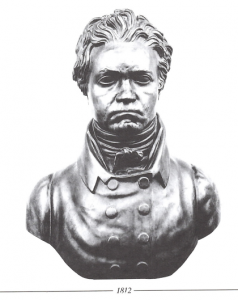
Beethoven in 1812 (from Beethoven 9 Symphonies by Karajan & BPO. DG-1963)
The popular opinion seems to be that Beethoven’s 2nd symphony is further down the road of innovation than his first. The much extended and rich Adagio introduction of the first movement, the witty and humorous sforzanti in the scherzo, and an elaborated coda of the final movement, all highlighted his talent and drive to break new grounds in the late classical era.
1. Adagio molto - Allegro con brio
Similar to his first symphony, the opening movement also has a slow introduction, however this one is much more expansive and richer, nearly three minutes into the movement:
As the introduction progresses, there is a brief moment of calling on the motif of Beenthoven’s Symphony No. 9’s opening theme, which is really astonishing:
The whole movement is a fast, energetic Allegro that starts on the main theme, which also bears somewhat similar rhythmic pattern to that of the first symphony:
The second theme is split between woodwinds and strings, first led by clarinet and basson, the answered by the strings:
We constantly hear the strings churning out a steady stream of eighth notes as accompanyment, this rythmic pattern played under fast tempo undoubtedly bolstered a sense of vigorous energy. Few examples:
2. Larghetto
Contrasting the first movement’s ever rushing force, the second movement is a relaxed smooth flow of pleasantry and sweetness. Theme one starts lightly on the string, much like singing a peaceful song:
The theme alternates between strings and woodwinds, as if two are exchanging elegant dialogues.
Theme two played by the first violin, simply another bright and sweet song-like melody:
3. Scherzo: Allegro vivo
The style of the third movement heads in opposite direction, again, of previous movement. Not only it’s now a true scherzo (as opposed to a minuet in previous work), it’s full of playful or even exaggerated dynamic shifts, notably lots of sforzanti. This is heard right at the beginning with the first theme:
Theme two quiets down a bit, played on oboe and bassoon:
4. Allegro molto
The finale is another fast, energetic and playful movement. Theme one has two parts:
A:
B:
Theme two has a rather simple melody played by oboe and bassoon, accompanied by jumping quarter notes on the string:
After recapitulation a coda emerges out of theme 1-B, much elaborated and grow nearly one third of the last movement, then propels the finale to the end.